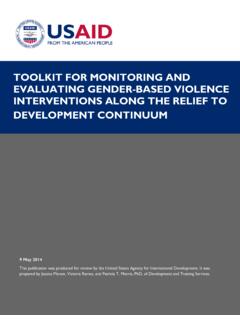Transcription of Congressional Oversight of Intelligence: Current Structure ...
1 Congressional Oversight of Intelligence: Current Structure and Alternatives L. Elaine Halchin Specialist in American National Government Frederick M. Kaiser Visiting Scholar May 14, 2012. Congressional Research Service 7-5700. RL32525. CRS Report for Congress Prepared for Members and committees of Congress Congressional Oversight of Intelligence: Current Structure and Alternatives Summary Interest in Congressional Oversight of intelligence has risen again in recent Congresses, in part because of disputes over reporting to Congress by intelligence community (IC) components on sensitive matters, including developments generated by the wars in Iraq and Afghanistan. The changes in the Oversight Structure adopted or proposed in recent Congresses, however, also reflect earlier concerns, such as increasing independent auditing authority for the Government Accountability Office (GAO) over the intelligence community, adding offices of inspectors general (OIGs), clarifying reporting requirements to Congress, and restructuring Congress's Oversight mechanisms.
2 Along these lines, the House Democratic majority had pledged in the 110th Congress to enact the remaining recommendations from the National Commission on Terrorist Attacks Upon the United States, commonly known as the 9/11 Commission. The Commission's unanimous 2004 report set the stage for a reconsideration of Congressional Oversight , concluding that it was dysfunctional. The commission proposed two distinct solutions: (1) creation of a joint committee on intelligence, modeled after the defunct Joint Committee on Atomic Energy, with authority to report legislation to each chamber; or (2). enhanced status and power for the existing select committees on intelligence, by making them standing committees and granting each one both authorization and appropriations power. Neither of these occurred, although Congress has made a number of changes in its Structure , organization, and authority to oversee this area. Despite these changes, several reports released during the 112th Congress by outside groups the Bipartisan Policy Center's National Security Preparedness Group, Commission on Weapons of Mass Destruction, and Council on Foreign Relations still concluded that Oversight of intelligence remained dysfunctional and counterproductive.
3 Proposals to create a joint committee on intelligence (JCI) date to 1948 and the early years of the Cold War, when the Central Intelligence Agency (CIA) and Director of Central Intelligence (DCI). were established. Similar plans have emerged in the meantime, although the lion's share were made before the establishment of the Senate Select Committee on Intelligence (SSCI) in 1976 and the House Permanent Select Committee on Intelligence (HPSCI) a year later. The numerous proposals for a JCI, which would end the two existing intelligence panels, moreover, vary and raise competing viewpoints over practical matters and matters of principle. Although Congress adopted neither of these 9/11 Commission proposals, the legislature has pursued other options to its intelligence Oversight Structure and capabilities. The House and Senate, for instance, have each altered the relationships between the intelligence committee and the appropriations committee.
4 Other changes were incorporated in the FY2010 Intelligence Authorization Act ( 111-259): clarifying the audit authority of GAO over the intelligence community; changing IC reporting and notification requirements; increasing the coordinative capabilities and reporting of relevant inspectors general (IGs); and adding a new IG covering the entire intelligence community as well as other IGs in four Defense Department entities. These changes were not without controversy and inter-branch conflict. In fact, this legislation was threatened with a presidential veto, although it was not exercised. Another veto threat arose over reporting proposals in the FY2012 Authorization Act, but the veto was not exercised, in part because these were substantially modified in the final version of the act ( 112-87). This report, to be updated as events dictate, describes the Current select committees on intelligence; characteristics and a model for a possible joint committee; recent actions by Congress; and obstacles affecting legislative Oversight in the field.
5 Congressional Research Service Congressional Oversight of Intelligence: Current Structure and Alternatives Contents 1. Intelligence as a Multi-Faceted 1. Proposals for a Joint Intelligence 2. Continuing Concerns About Congressional 2. Controversy, Conflict, and Recent 3. Coverage of This 5. House and Senate Select committees on 5. Jurisdiction and Authority .. 6. Membership and Leadership .. 7. Secrecy 7. Joint Committee on Atomic Energy as a Model .. 8. Proposed Joint Committee on Intelligence Characteristics .. 9. Methods of Establishment .. 9. Jurisdiction and Authority .. 10. 10. Terms and 10. Leadership .. 11. Secrecy 11. Staffing .. 11. Budget and Funding .. 12. Pros and 12. 12. 14. Alternatives to a Joint Committee .. 16. Changing the Select committees ' Structure and 16. Senate Action .. 17. House 20. Concerns about Restructuring the Intelligence committees .. 20. Improving Coordination Between the Two Intelligence Panels.
6 22. Joint 22. Leadership Meetings .. 23. Constraints on 23. Enhancing Interchanges with Other Panels and Members .. 23. Goals .. 23. 24. Limitations .. 24. Other Options .. 25. Increasing the Use of Congressional Support 25. Clarifying and Enhancing GAO's Authority to Audit the IC .. 25. Enhancing the Inspectors 31. Changing Notification and Reporting Requirements .. 33. Applying GPRA Requirements to the CIA .. 33. Observations on Oversight of Intelligence .. 34. Obstacles to 34. Secrecy 34. Congressional Research Service Congressional Oversight of Intelligence: Current Structure and Alternatives Perceived Limited Appeal of Intelligence Oversight .. 35. Overcoming the 35. Objectives and 35. Proposals for Change .. 35. Contacts Author Contact 37. Acknowledgments .. 37. Congressional Research Service Congressional Oversight of Intelligence: Current Structure and Alternatives Introduction Congress has long considered various ways to oversee intelligence, an often perplexing, sometimes controversial, and always difficult responsibility.
7 These conditions arise because of the secrecy and sensitivity surrounding intelligence findings, conclusions, dissemination, and sources and methods as well as competition between the legislature and executive for influence over and access to The field has become more complicated and demanding in the aftermath of the terrorist attacks on September 11, 2001, with the need for improved information sharing to overcome the foreign-domestic divide that has hampered effective intelligence gathering, evaluation, and Congressional Oversight of intelligence has evolved, especially since the mid-1970s and more recently since 9/11. Yet it continues to be criticized by some as being inadequate, ineffective, or worse, while at the same time, proposals to change it have been met with challenges both from within the legislature itself and from the executive. Intelligence as a Multi-Faceted Phenomenon The Current state of affairs reflects a multi-faceted phenomenon.
8 Not only does intelligence . overlap both foreign and domestic areas; but it also covers a diversity of subjects, agencies, and procedures within each. Oversight of intelligence, particularly in the foreign realm, is consolidated to a large degree in the House and Senate Select committees on Intelligence. But it is not centralized there; each panel has exclusive legislative authority over only the Central Intelligence Agency (CIA) and Director of National Intelligence (DNI). A number of other 1. Among many other sources examining Congressional Oversight of intelligence and executive-legislative relations in the area, see Loch K. Johnson and James J. Wirtz, eds., Strategic Intelligence: Windows Into a Secret World (An Anthology) (Los Angeles, Roxbury Publishing Co., 2004), Accountability and Civil Liberties, pp. 345-427; L. Britt Snider, The Agency and the Hill: CIA's Relationship with Congress, 1946-2004 (Washington, Center for the Study of Intelligence, Central Intelligence Agency, 2008), and Sharing Secrets with Lawmakers: Congress as a User of Intelligence (Washington, Center for the Study of Intelligence, CIA, 1997); Mark M.
9 Lowenthal, Oversight , . Intelligence: From Secrets to Policy (Washington, DC, CQ Press, 2012); Frank J. Smist, Congress Oversees the United States Intelligence Community, 1947-1994 (Knoxville, University of Tennessee Press, 1994); John M. Oseth, Regulating Intelligence Operations: A Study in the Definition of the National Interest (Lexington, University of Kentucky Press, 1985); David M. Barrett, The CIA and Congress: The Untold Story from Truman to Kennedy (Lawrence, University Press of Kansas, 2005); Anne Joseph O'Connell, The Architecture of Smart Intelligence: Structuring and Overseeing Agencies in the Post-9/11 World, California Law Review, vol. 94, 2006; Robert Jervis, Why Intelligence and Policymakers Clash, Political Science Quarterly, vol. 125, 2010; Amy Zegart, The Domestic Politics of Irrational Intelligence Oversight , Political Science Quarterly, vol. 126, 2011; Frederick M. Kaiser, Congress and the Intelligence Community: Taking the Road Less Traveled, in Roger H.
10 Davidson, ed., The Postreform Congress (New York, St. Martins Press, 1992); and Senate Select Committee on Intelligence, Legislative Oversight of Intelligence Activities: The Experience, Senate Print, 103-88, 103rd Congress, 2nd sess. (Washington, GPO, 1994). A number of CRS reports dealing with the areas include CRS Report RL33742, 9/11. Commission Recommendations: Implementation Status, by Richard F. Grimmett; CRS Report R40240, Intelligence Authorization Legislation: Status and Challenges, by Richard F. Grimmett; CRS Report R40136, Congress as a Consumer of Intelligence Information, by Richard A. Best Jr.; CRS Report RL33639, Sources of Systemic Risk in Large Value Interbank Payment Systems, by Edward V. Murphy; CRS Report R40602, The Department of Homeland Security Intelligence Enterprise: Operational Overview and Oversight Challenges for Congress, by Jerome P. Bjelopera; and CRS Report RL33616, Homeland Security Intelligence: Perceptions, Statutory Definitions, and Approaches, by Mark A.
















